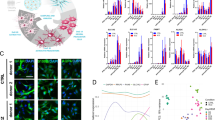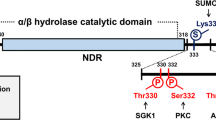Abstract
Mutations in the gene encoding the transcriptional modulator methyl-CpG binding protein 2 (MeCP2) are responsible for the neurodevelopmental disorder Rett syndrome which is one of the most frequent sources of intellectual disability in women. Recent studies showed that loss of Mecp2 in astrocytes contributes to Rett-like symptoms and restoration of Mecp2 can rescue some of these defects. The goal of this work is to compare gene expression profiles of wild-type and mutant astrocytes from Mecp2308/y mice (B6.129S-MeCP2<tm1Heto>/J) by using Affymetrix mouse 2.0 microarrays. Results were confirmed by quantitative real-time RT-PCR and by Western blot analysis. Gene set enrichment analysis utilizing Ingenuity Pathways was employed to identify pathways disrupted by Mecp2 deficiency. A total of 2152 genes were statistically differentially expressed between wild-type and mutated samples, including 1784 coding transcripts. However, only 257 showed fold changes >1.2. We confirmed our data by replicative studies in independent primary cultures of cortical astrocytes from Mecp2-deficient mice. Interestingly, two genes known to encode secreted proteins, chromogranin B and lipocalin-2, showed significant dysregulation. These proteins secreted from Mecp2-deficient glia may exert negative non-cell autonomous effects on neuronal properties, including dendritic morphology. Moreover, transcriptional profiling revealed altered Nr2f2 expression which may explain down- and upregulation of several target genes in astrocytes such as Ccl2, Lcn2 and Chgb. Unraveling Nr2f2 involvement in Mecp2-deficient astrocytes could pave the way for a better understanding of Rett syndrome pathophysiology and offers new therapeutic perspectives.




Similar content being viewed by others
References
Amir, R. E., Van den Veyver, I. B., Wan, M., Tran, C. Q., Francke, U., & Zoghbi, H. Y. (1999). Rett syndrome is caused by mutations in X-linked MECP2, encoding methyl-CpG-binding protein 2. Nature Genetics, 23, 185–188.
Andoh-Noda, T., Akamatsu, W., Miyake, K., Matsumoto, T., Yamaguchi, R., Sanosaka, T., et al. (2015). Differentiation of multipotent neural stem cells derived from Rett syndrome patients is biased toward the astrocytic lineage. Molecular Brain, 27, 31.
Authier, H., Billot, K., Derudder, E., Bordereaux, D., Rivière, P., Rodriguez-Ferreira, S., et al. (2014). IKK phosphorylates RelB to modulate its promoter specificity and promote fibroblast migration downstream to TNF receptors. Proceedings of the National Academy of Sciences of USA, 111, 14795–14799.
Ballas, N., Lioy, D. T., Grunseich, C., & Mandel, G. (2009). Non-cell autonomous influence of MeCP2-deficient glia on neuronal dendritic morphology. Nature Neurosciences, 12, 311–317.
Ben-Shachar, S., Chahrour, M., Thaller, C., Shaw, C. A., & Zoghbi, H. Y. (2009). Mouse models of MeCP2 disorders share gene expression changes in the cerebellum and hypothalamus. Human Molecular Genetics, 18, 2431–2442.
Bi, F., Huang, C., Tong, J., Qiu, G., Huang, B., Wu, Q., et al. (2013). Reactive astrocytes secrete lcn2 to promote neuron death. Proceedings of the National Academy of Sciences of USA, 110, 4069–4074.
Bienvenu, T., & Chelly, J. (2006). Molecular genetics of Rett syndrome: when DNA methylation goes unrecognized. Nature Review Genetics, 7, 415–426.
Boutant, M., Ramos, O. H., Tourrel-Cuzin, C., Movassat, J., Ilias, A., Vallois, D., et al. (2012). COUP-TFII controls mouse pancreatic β-cell mass through GLP-1-β-catenin signaling pathways. PLoS ONE, 7, e30847.
Chahrour, M., Jung, S. Y., Shaw, C., Zhou, X., Wong, S. T., Qin, J., & Zoghbi, H. Y. (2008). MeCP2, a key contributor to neurological disease, activates and represses transcription. Science, 320, 1224–1229.
Colantuoni, C., Jeon, H., Hyde, K., Chenchik, A., Khimani, A. H., Narayanan, V., et al. (2001). Gene expression profiling in postmortem Rett Syndrome brain: differential gene expression and patient classification. Neurobiology of Diseases, 8, 847–865.
De Filippis, B., Ricceri, L., & Laviola, G. (2010). Early postnatal behavioral changes in the Mecp2-308 truncation mouse model of Rett syndrome. Genes Brain and Behaviour, 9, 213–223.
Díaz-Vera, J., Morales, Y. G., Hernández-Fernaud, J. R., Camacho, M., Montesinos, M. S., Calegari, F., et al. (2010). Chromogranin B gene ablation reduces the catecholamine cargo and decelerates exocytosis in chromaffin secretory vesicles. Journal of Neurosciences, 30, 950–957.
Ebert, D. H., Gabel, H. W., Robinson, N. D., Kastan, N. R., Hu, L. S., Cohen, S., et al. (2013). Activity-dependent phosphorylation of MeCP2 threonine 308 regulates interaction with NCoR. Nature, 499, 341–345.
Ferreira, A. C., Pinto, V., Dá Mesquita, S., Novais, A., Sousa, J. C., Correia-Neves, M., et al. (2013). Lipocalin-2 is involved in emotional behaviors and cognitive function. Frontiers Cell Neurosciences, 7, 122.
Gebicke-Haerter, P. J., Bauer, J., Schobert, A., & Northoff, H. (1989). Lipopolysaccharide-free conditions in primary astrocyte cultures allow growth and isolation of microglial cells. Journal of Neurosciences, 9, 183–194.
Horike, S., Cai, S., Miyano, M., Cheng, J. F., & Kohwi-Shigematsu, T. (2005). Loss of silent chromatin looping and impaired imprinting of DLX5 in Rett syndrome. Nature Genetics, 37, 31–40.
Irizarry, R. A., Wu, Z., & Jaffee, H. A. (2006). Comparison of Affymetrix genechip expression measures. Bioinformatics, 22, 789–794.
Jacque, E., Tchenio, T., Piton, G., Romeo, P. H., & Baud, V. (2005). RelA repression of RelB activity induces selective gene activation downstream of TNF receptors. Proceedings of the National Academy of Sciences of USA, 102, 14635–14640.
Klose, R. J., Sarraf, S. A., Schmiedeberg, L., McDermott, S. M., Stancheva, I., & Bird, A. P. (2005). DNA binding selectivity of MeCP2 due to a requirement for A/T sequences adjacent to methyl-CpG. Molecular Cell, 19, 667–678.
Landén, M., Davidsson, P., Gottfries, C. G., Grenfeldt, B., Stridsberg, M., & Blennow, K. (1999). Reduction of the small synaptic vesicle protein synaptophysin but not the large dense core chromogranins in the left thalamus of subjects with schizophrenia. Biology of Psychiatry, 46, 1698–1702.
Lioy, D. T., Garg, S. K., Monaghan, C. E., Raber, J., Foust, K. D., Kaspar, B. K., et al. (2011). A role for glia in the progression of Rett’s syndrome. Nature, 475, 497–500.
Lyst, M. J., Ekiert, R., Ebert, D. H., Merusi, C., Nowak, J., Selfridge, J., et al. (2013). Rett syndrome mutations abolish the interaction of MeCP2 with the NCoR/SMRT co-repressor. Nature Neurosciences, 16, 898–902.
Maezawa, I., Swanberg, S., Harvey, D., LaSalle, J. M., & Jin, L. W. (2009). Rett syndrome astrocytes are abnormal and spread MeCP2 deficiency through gap junctions. Journal of Neurosciences, 29, 5051–5061.
Marksteiner, J., Lechner, T., Kaufmann, W. A., Gurka, P., Humpel, C., Nowakowski, C., et al. (2000). Distribution of chromogranin B-like immunoreactivity in the human hippocampus and its changes in Alzheimer’s disease. Acta Neuropathology, 100, 205–512.
Naka, H., Nakamura, S., Shimazaki, T., & Okano, H. (2008). Requirement for COUP-TFI and II in the temporal specification of neural stem cells in CNS development. Nature Neurosciences, 11, 1014–1023.
Nguyen, M. V., Felice, C. A., Du, F., Covey, M. V., Robinson, J. K., Mandel, G., et al. (2013). Oligodendrocyte lineage cells contribute unique features to Rett syndrome neuropathology. Journal of Neurosciences, 33, 18764–18774.
Okabe, Y., Takahashi, T., Mitsumasu, C., Kosai, K., Tanaka, E., & Matsuishi, T. (2012). Alterations of gene expression and glutamate clearance in astrocytes derived from an MeCP2-null mouse model of Rett syndrome. PLoS ONE, 7, e35354.
Okamura, M., Kudo, H., Wakabayashi, K., Tanaka, T., Nonaka, A., Uchida, A., et al. (2009). COUP-TFII acts downstream of Wnt/beta-catenin signal to silence PPARgamma gene expression and repress adipogenesis. Proceedings of the National Academy of Sciences of USA, 106, 5819–5824.
Sadakata, T., Mizoguchi, A., Sato, Y., Katoh-Semba, R., Fukuda, M., Mikoshiba, K., et al. (2004). The secretory granule-associated protein CAPS2 regulates neurotrophin release and cell survival. Journal of Neurosciences, 24, 43–52.
Shahbazian, M., Young, J., Yuva-Paylor, L., Spencer, C., Antalffy, B., Noebels, J., et al. (2002). Mice with truncated MeCP2 recapitulate many Rett syndrome features and display hyperacetylation of histone H3. Neuron, 35, 243–254.
Williams, E. C., Zhong, X., Mohamed, A., Li, R., Liu, Y., Dong, Q., et al. (2014). Mutant astrocytes differentiated from Rett syndrome patients-specific iPSCs have adverse effects on wild-type neurons. Human Molecular Genetics, 23, 2968–2980.
Yasui, D. H., Peddada, S., Bieda, M. C., Vallero, R. O., Hogart, A., Nagarajan, R. P., et al. (2007). Integrated epigenomic analyses of neuronal MeCP2 reveal a role for long-range interaction with active genes. Proceedings of the National Academy of Sciences of USA, 104, 19416–19421.
Yasui, D. H., Xu, H., Dunaway, K. W., Lasalle, J. M., Jin, L. W., & Maezawa, I. (2013). MeCP2 modulates gene expression pathways in astrocytes. Molecular Autism, 4, 3.
Acknowledgments
This work was supported by Institut National de la Santé et de Recherche Médicale, and the Association Française du Syndrome de Rett (AFSR), and Fondation Jerome Lejeune (FJL R12212KK). CD is supported by the LabEX “Who Am I?” (PRES Sorbonne Paris Cité, Paris Diderot, Paris Descartes, CNRS, INSERM). We thank Florent Dumont at the sequencing platform and the staff of the animal facilities (Institut Cochin, Paris, France).
Author information
Authors and Affiliations
Corresponding author
Ethics declarations
Conflict of interests
The authors state that they have no conflict of interest.
Animal Rights
We state that all procedures involving animals were approved by the Inserm bioethical committee and have been carried out in accordance with the European law.
Electronic supplementary material
Below is the link to the electronic supplementary material.
Table S1
List of 257 dysregulated genes with at least a 1.20-fold expression variation among the 2152 coding and uncoding genes with significantly different expression between wild-type and Mecp2-deficient astrocytes. 130 genes were overexpressed and 127 were underexpressed in mutant astrocytes compared to wild-type astrocytes. p values and absolute expression values are indicated. (XLS 103 kb)
Rights and permissions
About this article
Cite this article
Delépine, C., Nectoux, J., Letourneur, F. et al. Astrocyte Transcriptome from the Mecp2308-Truncated Mouse Model of Rett Syndrome. Neuromol Med 17, 353–363 (2015). https://doi.org/10.1007/s12017-015-8363-9
Received:
Accepted:
Published:
Issue Date:
DOI: https://doi.org/10.1007/s12017-015-8363-9




